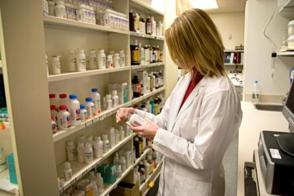Chemical Agents in Health and Social Care

The use of chemicals is widespread in health and social care settings and includes chemicals such as:
- cleaning agents
- disinfecting and sterilising agents
- laboratory chemicals
- medical gases
- anaesthetic agents
- hazardous medicinal products.
Effects of Chemicals
Any chemical that has the potential to cause harm is called a hazardous chemical. Such chemicals may:
- cause health effects, for example be a respiratory sensitiser or skin irritant or sensitiser;
- be a physical hazard, for example a flammable, explosive or oxidising chemical;
- affect the environment, if they are used, stored or disposed of incorrectly.
Routes of Exposure
Health and social care workers (and in certain cases, the unborn child) may suffer health effects when dangerous chemicals enter the body. The main routes of exposure are:
- inhalation: breathing in the chemical;
- absorption: through skin contact or a splash in the eye;
- ingestion: via contaminated food or hands; and
- inoculation: when a sharp object such as a needle punctures the skin.
The Law
The Safety, Health and Welfare at Work (Chemical Agents) Regulations 2001 (as amended) and the Safety, Health and Welfare at Work (Carcinogens, Mutagens and Reprotoxic Substances) Regulations 2024, require that employers must assess any work activity likely to involve a risk of exposure to chemicals agents and carcinogenic, mutagenic and reprotoxic substances. For information on chemical risk assessment see Your Steps to Chemical Safety. Employers should also have emergency plans and procedures in the event of an uncontrolled release, leak or spillage of a hazardous chemical.
Further Information
- Chemical Agents, Health and Safety Authority.
- Hazardous Medicinal Products, Health and Safety Authority.
- Disinfectants, Health and Safety Authority.




